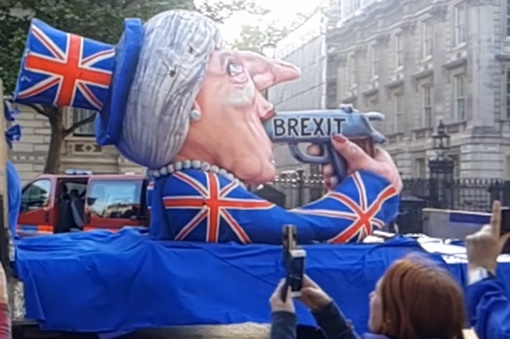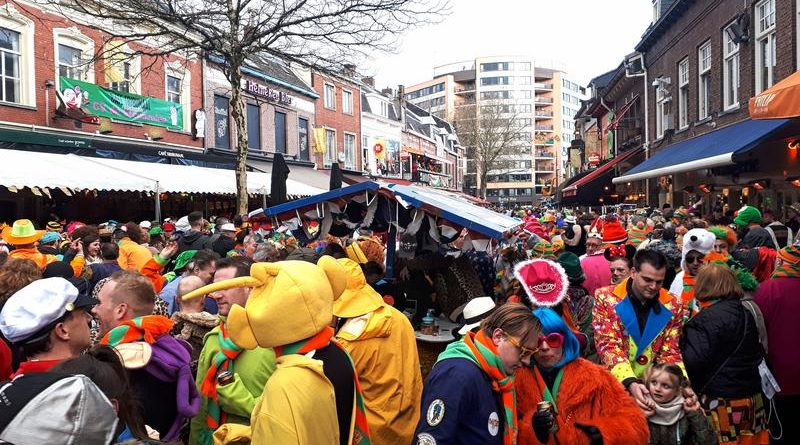Guide to the Carnival Celebrations in the Netherlands
This destination trip report and special guide will cover the carnival celebrations in the south of the Netherlands.
Arrival
After my delayed KLM flight from Stavanger to Amsterdam I was happy to have finally arrived in the Netherlands. As I was rather desperate to catch a certain southbound train in order to arrive on time for the big carnival parade, I was glad once I finally sat down in the train realising I would still make it.
Train to the south of the Netherlands
The train connections from Amsterdam’s Schiphol Airport to many destinations south in the country have been tremendously improved since I last used it some five years ago. A special intercity train now uses the same high speed railway line towards Rotterdam which is also used by the high speed Thalys trains to Paris and the Eurostar to London.
These “IC Direct Trains” as they are marketed are however hauled by a normal electric locomotive and don’t reach anywhere near Japanese bullet train speeds of 300kph. Still, at speeds around 160-180kph, they do shave off some 30-40 minutes of the normal travel time.
At Rotterdam Central Station it was an easy change of trains to take me onwards to the southern Dutch city of Tilburg where I would celebrate carnival with some friends.


Carnival
Carnival, traditionally a Catholic festival with pagan influences, is celebrated in winter (dates varying each year, but always in February or March) in many countries across the world. We all know the famous carnival in Rio de Janeiro, or perhaps the one in places like Venice, but not many know that some of the best parties can actually be found in the Netherlands.
Don’t take my word for it. Brazilian football legend Romário said that after Brazil the best carnival parties can be found in the Netherlands. And if someone can know it, then it is Rio de Janeiro-born party animal Romário, who got initiated into Dutch carnival traditions while playing at PSV Eindhoven before his big transfer to Barcelona.
Two southern provinces
In the Netherlands, carnival is basically only celebrated in the two southernmost Dutch provinces (North Brabant and Limburg) and in some parts straddling the German border to the east. In North Brabant the festival is known under the basic Dutch translation of carnaval, while Limburgers prefer to say vastelaovend instead, which means “Eve of Lent” in the local dialect.
While local traditions can vary hugely from town to town and there are big differences between the way the people in Limburg and North Brabant celebrate, there are a few factors the festival has in common. Some uninitiated people would say that carnival is all about getting drunk, flirting and partying. While for many revellers these are indeed important aspects and carnival parties can be wild fun – the festival is so much more than just this.
For a total of five days (Friday until Tuesday) the cities and towns where carnival is celebrated come to a standstill. But even as early as three months before, there are run-up parties, lots of preparations and small traditions leading to the main event. Some float builders even work for an entire year on their creations which they show off during the big parade.
Especially parade day is a moment which is celebrated equally by young and old who are all on the streets to party, to catch up or just to admire the floats.

Role reversal
The idea behind carnival is a giant reversal of roles. For the duration of carnival, the Mayor symbolically hands over the keys of the town to the person elected as Prince Carnival, who heads the Council Of Eleven which organises all main carnival activities but for most also have a big symbolic function. Local carnival clubs also play a huge role in organising parties and smaller events across town.
People on the streets dress up in a wild variety of different costumes. In North Brabant for example, people either dress up in an idiotic or sexy way (for example, in a duck costume or as a sexy nurse) or come with their entirely own creation to wear. Most locals however, dress up in a kind of traditional blue farmer’s overall, which are often decorated with emblems from the carnival club they belong to or other funny patches.
In the city of Tilburg, you will see locals wear orange-and-green scarves or other accessories to set themselves apart from people from different cities, as orange-and-green are Tilburg’s colours during Carnival. In the city of Den Bosch for example, the omnipresent colours are red-white-yellow which you would see there everywhere if you happen to celebrate carnival in that city.
Carnival parade
Carnival suits and parade floats are often designed to criticise society. It is the time where you can freely mock whatever you want: celebrity figures, politics, religion or whatever else you fancy to ridicule. This might not always be easy to grasp for a foreigner as lots of statements involve local politics or funny word plays in the Dutch language, although this is not always the case.
In western Germany, where carnival has many similarities with the Netherlands, the float builders of the famous carnival parades of Dusseldorf and Cologne often will take on world issues.
The image below is from a carnival float which was used in Dusseldorf and meant to mock Brexit and British PM Theresa May. It might make you help getting the point what such parades and carnival in general is all about – it is using humour to criticise all kinds of societal issues!

Tilburg parade
At the parade in Tilburg, me and my friends were lucky to have a few crates of cold beers with us, which saved us from the need to buy overpriced beer from the huge queues which form in the cities’ pubs and outdoor stands. In between copious amounts of beer, locals in Tilburg also drink plenty of shots of ‘schrobbeler‘, which is a local herbal liquor, in order to stay warm.
Remember that carnival in the Netherlands is no Rio de Janeiro where it is a sunny 30 degrees Celsius! Temperatures can easily hit below zero so it is of the utmost importance to keep on dancing, moving and drinking.


Prince Carnaval
In the Netherlands, the last float in the parade is traditionally the one where Prince Carnival and his Council of Eleven stand on top.

Carnival parties
After the parade, the party really kicks in as all bars, streets and squares in the city centre fill up with revellers drinking and dancing the night away. One aspect which I personally always loved about carnival is how much it changes he mindset of the people. While during normal nights out everybody normally minds their own business, carnival is a time where everyone feels united and goes crazy.
People actually talk with others and seem to be more open-minded, friendly and welcoming than during any other time of the year. Normal barriers break as the entire city, young and old, just combines their efforts in making it a fun week-long party. Even those who are new to carnival would have an easy time making new friends and quickly get accustomed to all the small traditions and local quirks.


Lots of booze
Needless to say, me and my old pals drank quite a few beers and shots that evening and had lots of fun celebrating, singing and dancing. Unfortunately, for me it would only be one day of partying, as the next morning I already needed to go back to Amsterdam to continue my journey on my big Siberian journey.

Trip report index
This review is part of the ‘Siberian Shuffle – A Crazy Winter Trip Around Eurasia‘ trip report, which consists of the following chapters:
1. Review: Wizz Air Bucharest to Oslo Sandefjord Torp (Airbus A321)
2. A Day in the Norwegian Capital of Oslo
3. Review: Norwegian Railways Night Train Oslo-Stavanger in a Private Sleeper
4. Review: Radisson Blu Royal Hotel, Stavanger
5. Stavanger – A Great Norwegian City Trip Surprise
6. Review: North Sea Lounge Stavanger Airport
7. Review: KLM Cityhopper Business Class Stavanger to Amsterdam (Embraer RJ-175)
8. Guide to the Carnival Celebrations in the Netherlands (current chapter)
9. Review: KLM Crown Lounge (Schengen) Amsterdam Airport
10. Review: Air France Business Class Amsterdam to Paris (Airbus A319)
11. Review: ‘Salon Paris’ Business Class Lounge Paris CDG Terminal 2C
12. Review: Aeroflot Business Class Paris to Moscow (Airbus A320)
13. Review: Aeroflot Domestic Business Class Lounge Moscow Sheremetyevo
14. Review: Aeroflot Domestic Business Class Moscow to Irkutsk (Boeing 737-800)
15. Review: Matreshka Hotel, Irkutsk
16. Irkutsk Trip Report: Exploring the ‘Paris of Siberia’ in Winter
17. Review: Mayak Hotel, Listvyanka (Lake Baikal)
18. A Winter Trip to the Frozen Wonderland of Lake Baikal
19. Review: Ibis Irkutsk Center Hotel, Irkutsk
20. Review: Domestic Business Class Lounge Irkutsk Airport
21. Review: Aeroflot Domestic Business Class Irkutsk to Moscow (Boeing 737-800)
22. Review: Pushkin Hotel, Moscow
23. A 24 Hour Stopover in the Russian Capital of Moscow
24. Review: ‘Moscow’ and ‘Jazz’ Business Lounges Moscow Sheremetyevo Terminal D
25. Review: Aeroflot Business Class Moscow to Paris (Airbus A320)
26. Review: TAROM Business Class Paris to Bucharest (Airbus A318)
27. Review: TAROM Business Lounge Bucharest Otopeni Airport
28. Review: Air France Business Class Bucharest to Paris (Airbus A320)
29. A Short Overnight Stopover in Paris
30. Review: Sheltair Business Lounge Paris CDG Terminal 2D
31. Review: Azerbaijan Airlines Business Class Paris to Baku (Airbus A320)
32. Review: Old City Hotel and Apartments, Baku, Azerbaijan
33. Destination Baku: An Intriguing Mix Between Old and New
34. Guide: Train Travel in Azerbaijan
35. Sheki: Azerbaijan’s Most Lovely Town and Springboard to the Caucasus
36. Must Be the Ganja! A Visit to the City of Ganja in Azerbaijan
37. Review: Shah Palace Hotel, Baku, Azerbaijan
38. Review: Azerbaijan Airlines Business Lounge Baku Airport
39. Review: Azerbaijan Airlines Business Class Baku to Paris (Airbus A320)
40. Review: Air France Business Lounge Paris CDG Terminal 2F
41. Review: KLM Business Class Paris to Amsterdam (Boeing 737)
42. Review: KLM Business Class Amsterdam to Bergen (Boeing 737)
43. Blissful Bergen – Is It Really Norway’s Most Beautiful City?
44. Review: Bergen to Oslo on a Norwegian Intercity Train (Bergensbanen Railway)
45. The Flamsbana Railway – From the Myrdal Mountains to the Fjord at Flam
46. Review: SAS Economy Class Oslo to Brussels (Boeing 737-600)
47. Review: Diamond Lounge Brussels Airport Pier B Non-Schengen
48. Review: TAROM Economy Class Brussels to Bucharest (Boeing 737-800)

